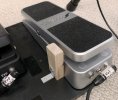Fotukito
Inspired
If you enjoy reading about delightfully over-engineered solutions, read on…
tldr; I’ve built an Arduino-based gadget to display LED patterns on my pedal board to visually inform me of the position of my EV-1, which I use as an Axe volume pedal.
The ‘Problem’...
As a part of a small live act (duo) playing with backing tracks, lots of MIDI-based automation, and mostly for events too casual to have anyone working FOH, our repertoire is necessarily ‘pre-mixed’ with repeatable gain staging from instrument to PA. Though the pre-programmed MIDI automation also takes care of my guitar volume changes within each song, I still have an EV-1 in expression mode to control my Axe FX III volume in case I want to make minor tweaks (+/- 3dB) or perform swells.
It’s important for the volume pedal to stay in the ‘nominal’ position, which is about 60% depressed, for most of a gig, since everything was gain-staged that way when we ‘pre-mixed’.
However, there’s no easy way to check if the pedal is that nominal position, other than to check a tiny text value I’ve got displayed on the Axe performance page, which is inconvenient during a gig.
How can I easily verify my volume pedal is in the right position to match our carefully pre-mixed gain staging??
The Solution…
Using an Arduino Uno processor, Adafruit LED matrix, and some software, I built a gadget mounted to my simple pedal board that ‘reads’ the position of the EV-1 (measuring the same voltage the Axe uses for its expression pedal processing) and then displays a LED pattern that reflects the corresponding Axe volume boost/cut.
See this 30 second video for an example of it working (LEDs don't capture well in an iPhone, but you can get the idea)...
Really, it’s just the pair of LEDs that tell me ‘pedal is nominal position’ that I really need; the rest of the LED patterns are just fun eye candy. But it was a fun project and interesting proof of concept, since the idea could be used with any expression pedal. (E.g., imagine a blinking red LED if you’ve left the wah cocked ;-)
tldr; I’ve built an Arduino-based gadget to display LED patterns on my pedal board to visually inform me of the position of my EV-1, which I use as an Axe volume pedal.
The ‘Problem’...
As a part of a small live act (duo) playing with backing tracks, lots of MIDI-based automation, and mostly for events too casual to have anyone working FOH, our repertoire is necessarily ‘pre-mixed’ with repeatable gain staging from instrument to PA. Though the pre-programmed MIDI automation also takes care of my guitar volume changes within each song, I still have an EV-1 in expression mode to control my Axe FX III volume in case I want to make minor tweaks (+/- 3dB) or perform swells.
It’s important for the volume pedal to stay in the ‘nominal’ position, which is about 60% depressed, for most of a gig, since everything was gain-staged that way when we ‘pre-mixed’.
However, there’s no easy way to check if the pedal is that nominal position, other than to check a tiny text value I’ve got displayed on the Axe performance page, which is inconvenient during a gig.
How can I easily verify my volume pedal is in the right position to match our carefully pre-mixed gain staging??
The Solution…
Using an Arduino Uno processor, Adafruit LED matrix, and some software, I built a gadget mounted to my simple pedal board that ‘reads’ the position of the EV-1 (measuring the same voltage the Axe uses for its expression pedal processing) and then displays a LED pattern that reflects the corresponding Axe volume boost/cut.
See this 30 second video for an example of it working (LEDs don't capture well in an iPhone, but you can get the idea)...
Really, it’s just the pair of LEDs that tell me ‘pedal is nominal position’ that I really need; the rest of the LED patterns are just fun eye candy. But it was a fun project and interesting proof of concept, since the idea could be used with any expression pedal. (E.g., imagine a blinking red LED if you’ve left the wah cocked ;-)

